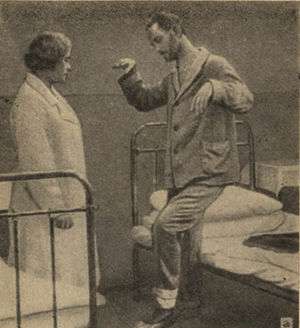Stupor
Stupor is the lack of critical mental function and a level of consciousness wherein an affected person is almost entirely unresponsive and only responds to intense stimuli such as pain.[1] The word derives from the Latin stupor ("numbness, insensibility").[2]
| Stupor | |
|---|---|
 | |
| A patient in catatonic stupor | |
| Specialty | Psychiatry |
Signs and symptoms
Stupor is characterised by impaired reaction to external stimuli. Those in a stuporous state are rigid, mute and only appear to be conscious, as the eyes are open and follow surrounding objects. If not stimulated externally, a patient with stupor will appear to be in a sleepy state most of the time. In some extreme cases of severe depressive disorders the patient can become motionless, lose their appetite and become mute.[1] Short periods of restricted responsivity can be achieved by intense stimulation (e.g. pain, bright light, loud noise, shock).
Causes
Stupor is associated with infectious diseases, complicated toxic states (e.g. heavy metals), severe hypothermia, mental illnesses (e.g. schizophrenia, severe clinical depression), epilepsy, vascular illnesses (e.g. hypertensive encephalopathy), shock (e.g. learning of a death or surviving a car crash), neoplasms (e.g. brain tumors), major trauma, vitamin D excess and other maladies.[3]
Lesions of the ascending reticular activation system on height of the pons and metencephalon have been shown to cause stupor. The incidence is higher after left-sided lesions.
Notes
- Gelder, M.; Mayou, R.; Geddes, J. (2005). Psychiatry (3rd ed.). New York: Oxford.
- Berrios, G. E. (1981). "Stupor: A Conceptual History". Psychological Medicine. 11: 677–688.
- Berrios, G. E. (1981). "Stupor Revisited". Comprehensive Psychiatry. 22: 466–478.
References
- C. Lafosse, Zakboek Neuropsychologische Symptomatologie, p. 37, ISBN 90-334-3995-6.